These are my personal views and experience of wildlife photography.
Walking through the fields, woods, parks etc with a camera round your neck rarely produces any good wildlife photographs. The best way is to sit down watch and wait. Even without a hide you will soon see something and may have an opportunity to photograph it.

For best results a bit of planning is needed. A make shift hide is easily thrown up and a bit of food that the subject likes will usually produce results.
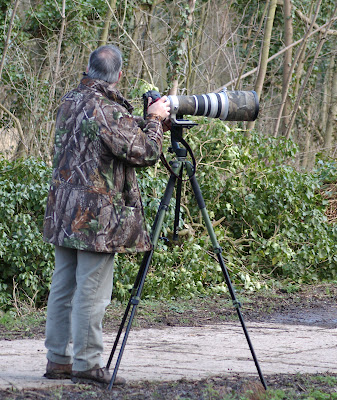
Equipment. Above is my friend Pete with his very, very expensive Canon lens. It is also very heavy and Pete rarely ventures into the thick woods with it or even further than a few hundred yards from the car. A lens like this requires a tripod and head that weigh a minimum the same as the lens and camera. Such lenses are best kept for touch line sports photos and easily accessed hides.

My friend Phil with his much better 170mm - 500mm zoom lens. These aren't that cheap and good ones are hard to come by but they will get more use and so more chance of better photos than a big monster lens. This one went back to the manufacturer to be recalibrated and now produces excellent results. Phil is seen here using it with the aid of a monopod. I find a 300mm (=450mm on crop DSLR) the best general purpose wildlife lens. It is light enough to be support on a monopod and won't break your back when out for the day.
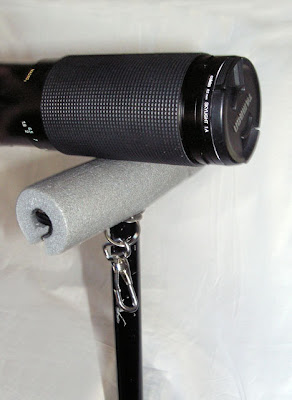
Support is essential when using any telephoto lens. I regularly use two different tripods, a large Manfrotto and a smaller more portable Manfrotto one. I also favour the use of a monopod and again use two different ones. A heavy one with a good Manfrotto ball head and a light monopod that I usually use with my home made camera support. Don't be tempted by cheap tripods. they will cost you more in lost pictures and being replaced that a good one. But even a cheap one is better than none.
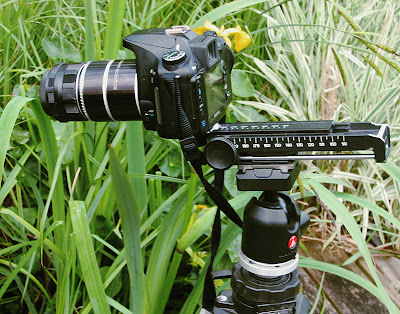
This is a focus rail (Home made) it is essential for macro photography and very useful on a telephoto lens. The rail is mounted on a manfrotto ball head and my heavy Manfrotto tripod.
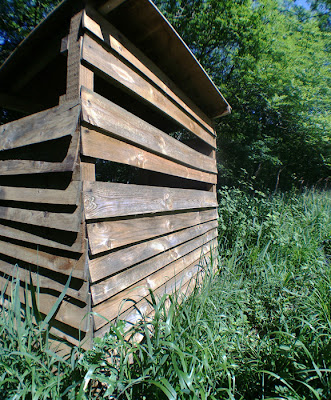
My local park 'Hide' that seems to overlook nothing.
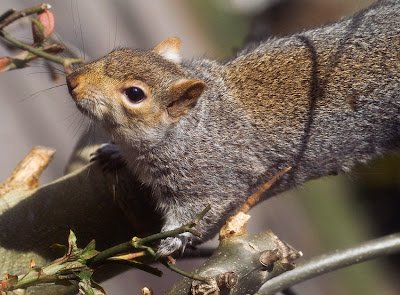
 One of the most difficult common birds to photograph is the Wren. They are just so small and timid
One of the most difficult common birds to photograph is the Wren. They are just so small and timid


 For best results a bit of planning is needed. A make shift hide is easily thrown up and a bit of food that the subject likes will usually produce results.
For best results a bit of planning is needed. A make shift hide is easily thrown up and a bit of food that the subject likes will usually produce results. Equipment. Above is my friend Pete with his very, very expensive Canon lens. It is also very heavy and Pete rarely ventures into the thick woods with it or even further than a few hundred yards from the car. A lens like this requires a tripod and head that weigh a minimum the same as the lens and camera. Such lenses are best kept for touch line sports photos and easily accessed hides.
Equipment. Above is my friend Pete with his very, very expensive Canon lens. It is also very heavy and Pete rarely ventures into the thick woods with it or even further than a few hundred yards from the car. A lens like this requires a tripod and head that weigh a minimum the same as the lens and camera. Such lenses are best kept for touch line sports photos and easily accessed hides. My friend Phil with his much better 170mm - 500mm zoom lens. These aren't that cheap and good ones are hard to come by but they will get more use and so more chance of better photos than a big monster lens. This one went back to the manufacturer to be recalibrated and now produces excellent results. Phil is seen here using it with the aid of a monopod. I find a 300mm (=450mm on crop DSLR) the best general purpose wildlife lens. It is light enough to be support on a monopod and won't break your back when out for the day.
My friend Phil with his much better 170mm - 500mm zoom lens. These aren't that cheap and good ones are hard to come by but they will get more use and so more chance of better photos than a big monster lens. This one went back to the manufacturer to be recalibrated and now produces excellent results. Phil is seen here using it with the aid of a monopod. I find a 300mm (=450mm on crop DSLR) the best general purpose wildlife lens. It is light enough to be support on a monopod and won't break your back when out for the day.
 This is a focus rail (Home made) it is essential for macro photography and very useful on a telephoto lens. The rail is mounted on a manfrotto ball head and my heavy Manfrotto tripod.
This is a focus rail (Home made) it is essential for macro photography and very useful on a telephoto lens. The rail is mounted on a manfrotto ball head and my heavy Manfrotto tripod. My local park 'Hide' that seems to overlook nothing.
My local park 'Hide' that seems to overlook nothing.